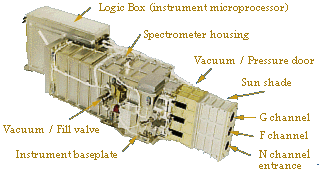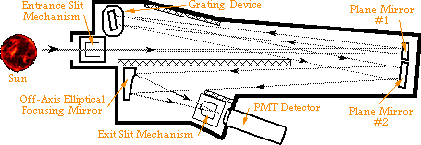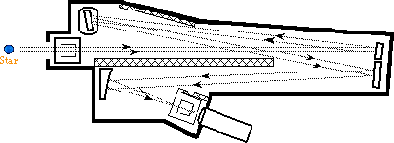Instrument

SOLSTICE is a three-channel grating spectrometer which uses the same optical elements for both the solar and stellar observations, but uses interchangeable entrance apertures, band passes, and integration times to accommodate the eight orders of magnitude difference between the solar and stellar irradiances. The three overlapping channels are the G channel from 119 nm to 190 nm ( = 0.1 nm), the F channel from 170 to 320 nm ( = 0.25 nm), and the N channel from 280 nm to 420 nm ( = 0.35 nm). Each SOLSTICE channel is identical, as shown below, but different coatings on the mirrors and different photocathodes on the PMT’s are chosen to optimize instrument sensitivity for each channel’s spectral range.
Solar Mode

The solar radiation enters through the spectrometer’s entrance slit and then reflects off the first mirror. The radiation is then divided into its many wavelengths by the diffraction grating. The grating rotation is controlled by the grating drive to direct a particular wavelength to the exit slit off the second mirror and ellipsoidal mirror. The ellipsoidal mirror focuses the entrance slit onto the exit slit for the highest possible spectral resolution. The photons are individually detected by the photomultiplier tube (PMT) that looks through the exit slit. The combination of these photon count rates at different wavelengths (by rotating the grating) make a spectrum.
Stellar Mode

The stellar radiation follows the same path as the solar radiation; therefore, the trends of the stellar irradiance is directly applicable to solar irradiances. That is, the data from the stable stellar sources determine the instrument degradation rates that are then applied to the solar data. Because the stellar radiation is much dimmer than the solar radiation, the entrance and exit slit sizes are significantly increased as well as the integration time for the data is increased for the stellar observations.
A detailed description of the SOLSTICE instrument design is given by Rottman et al. (“Solar Stellar Irradiance Comparison Experiment 1: 1. instrument design and operation”, J. Geophys. Res., 98, 10667-10678, 1993).
